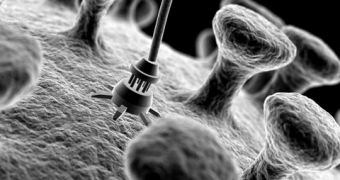Nowadays, computers rely on solid state transistors and other electronic components to compute ones and zeros. This works great until the size of a single transistor goes beyond a certain limit, where miniaturization can no longer take place, as the electronic components would be only a few atoms wide. Engineers and scientists from the University of Wisconsin-Madison teamed up in an attempt to find an alternative solution and the answer according to them is the nanomechanical computer.
Inside a traditional computer there are no moving parts, with the exception of the optical and disk drives; every computing operation is done by microscopic transistors and other components. The nanomechanical computer comes with a different way, because it has many moving parts that are assembled in switches, logic gates and memory units. Both the traditional design and the nanomechanical computer rely on the movement of electrons, but the new approach is to use the push and pull of the moving parts to control the electrons. According to Robert Blick, a professor of electrical and computer engineering at the University of Wisconsin-Madison, the goal is to create a completely different king of computer: "The aim is to have a new type of device for computing applications".
The idea of using movement to power a computing machine is not new, the most famous example is the 19th century "difference engine" built by the English mathematician Charles Babbage and during the 1950s all sorts of mechanical hand-held calculators appeared. While the nanomechanical computer will not directly compete with the traditional solid state design, it will be more suited for environments that require a more stable and rugged design than conventional silicon chips. Some of the potential uses of the nanomechanical computer rely exactly on its ability to withstand shocks and extreme environments like space, car engines, battlefields and children's toys. Another good point of the nanomechanical computers would be that they need less power and that they can work at much higher temperatures than their traditional counterparts, eliminating the need of cooling systems. As they are more energy efficient, they may well be the future of mobile computing where battery life is an important factor.
The research group already has a moving prototype of a single transistor, the building block of all modern computers and now they are in the process of aligning more components in order to construct a working circuit. "We've tested these single devices and we've shown that a single element works," says Blick. "The next step is to demonstrate memory. We're starting with the basics of information engineering". To make the most of the new design, these circuits will be built of other materials than silicon. According to the research team, one possible candidate is the ultra-hard diamond film that can be processed using industrial scale already existing technologies.

 14 DAY TRIAL //
14 DAY TRIAL //